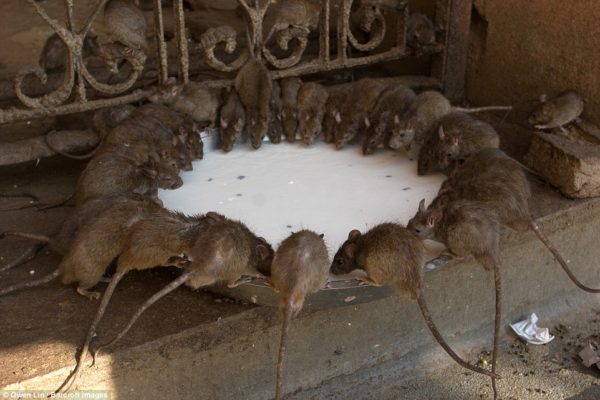The Karni Mata Temple in remote Deshnoke, Rajasthan is overrun by animals which scurry though its stone halls.The rats are seen as holy because legend says they are the reincarnated children of revered goddess Karni Mata.Rodents move freely within the temple and often eat from huge bowls of milk and grains, placed daily by devotees.
An Indian temple is infested with more than 20,000 rats and visitors flock from far and wide to worship the rodents normally perceived as the scourge of the earth. The Karni Mata Temple in remote Deshnoke, Rajasthan is known as the ‘Temple of Rats’ because it is overrun by the animals which scurry though its stone halls.The rodents, called kabbas, are revered by both tourists and locals who have gone to great lengths to protect the species by building netting and grills to keep out predators such as raptors.
Popular: The Karni Mata Temple (pictured) in remote Deshnoke, Rajasthan is known as the ‘Temple of Rats’ because it is overrun by the animals which scurry though its stone halls
The rats are seen as holy because legend claims that when the goddess Karni Mata’s stepson was reincarnated by Yama, the god of death, he also allowed all of the goddess’s children to be reincarnated as rats. There are conflicting stories behind the legend, and one version alleges that when a 20,000 strong army fled to Deshnoke, a sin punishable by death, Karni Mata showed mercy and turned them into rats instead. In response, the army promised to serve Karni Mata in her temple forever.
Surender Sharma, a visitor, said: This is my first visit to this temple. There is no history of plague in this area, despite the presence of rats for many years. People come here to worship rats as god.’The rodents move freely within the temple and can be seen eating from a huge metal bowl of milk and grains, placed there daily by devotees.
Many visitors offer sweets and other candy to the vermin. The food nibbled by the rats is also considered holy and is sometimes consumed by a devotee – even if it has been half eaten by rodents. Savita Sharma, another visitor, said: ‘I keep visiting this temple. The first time I visited this place I was glad to see rats all around. But I did scream out loudly when a rat touched my foot.’ While black and brown rats are easily spotted in the temple courtyard, devotees believe sighting a white rat is a blessing.
One visitor named Mishra said: ‘I have come to see rats and white rat is considered lucky. If someone see’s a white rat then he or she gets good luck and the blessings of god. I am glad that I have seen a white rat.’
One visitor named Mishra said: ‘I have come to see rats and white rat is considered lucky. If someone see’s a white rat then he or she gets good luck and the blessings of god. I am glad that I have seen a white rat’.
Canadian based photographer, Owen Lin, travelled to the temple to witness the peculiar sight.
He said: ‘We went for the spectacle and the oddity of it. We were a little apprehensive about going, because we didn’t really know what to expect.‘It was kind of quiet when we got there and we weren’t sure it would be worth the trip, but once you went in further and looked around the temple you saw areas of the temple that were infested with rats. ‘Personally rats don’t scare me, so I wasn’t too freaked out, but if you’re scared of rats then it’s really going to cause you some stress.
‘They weren’t terribly shy, they didn’t seem to care about people too much and they weren’t really aggressive. ‘They seem to be just trying to eat mainly. Some of them were pretty healthy and some of them looked a little raggedy.’
Even though the explorer saw a few dead rats dotted about, he said the temple was well cared for and was very clean considering its rodent population.
According to the temple rules, stepping accidentally on rat and killing it is a sin. The perpetrator is then bound to buy a gold or silver rat statue and place it in the temple as a payment of sin
Mr Lin was momentarily concerned about having to remove his shoes, as is customary in Indian temples, but once inside he said there were very few rat droppings.
He added: ‘It just sounded outrageous – someone devoting an entire temple to these rats. We were in the area and we just had to go. ‘I’m not sure how many people bother going, so it was refreshing to visit a relatively untouched area.’
Currently the temple is mainly visited by worshippers, who place their offerings to the goddess in the centre of the temple – with one man offering a big bottle of alcohol for the goddess. Priests at the temple treat the furry inhabitants with serious devotion and warn visitors to walk carefully within the temple premises to avoid trampling them.
According to the temple rules, stepping accidentally on rat and killing it is a sin. The perpetrator is then bound to buy a gold or silver rat statue and place it in the temple as a payment of sin.







Leave a reply